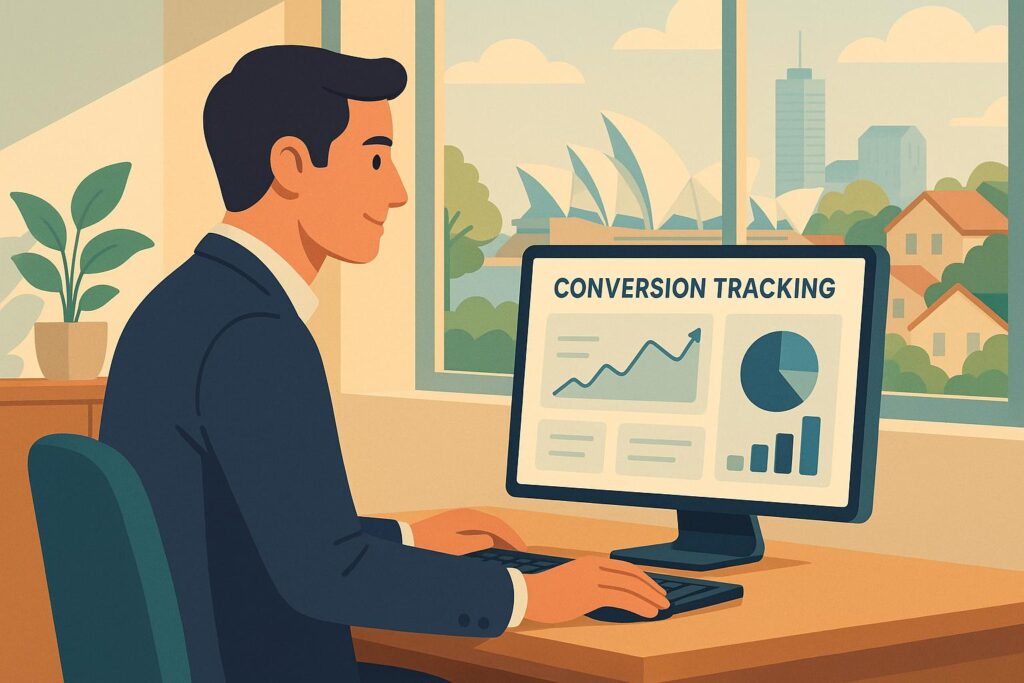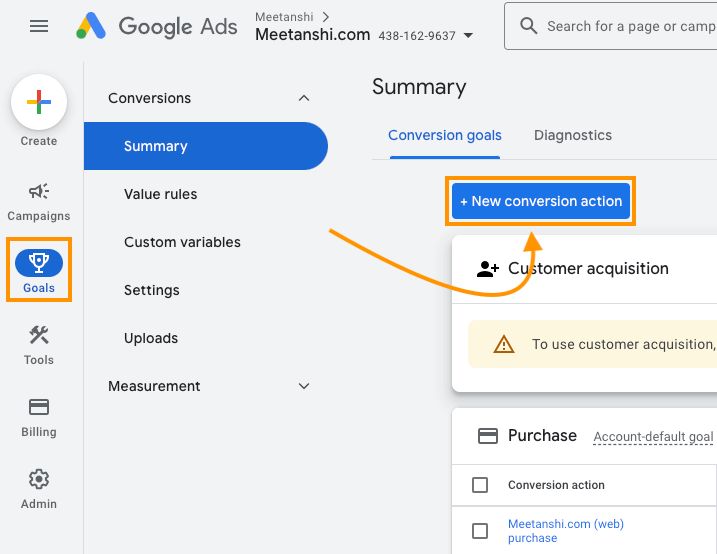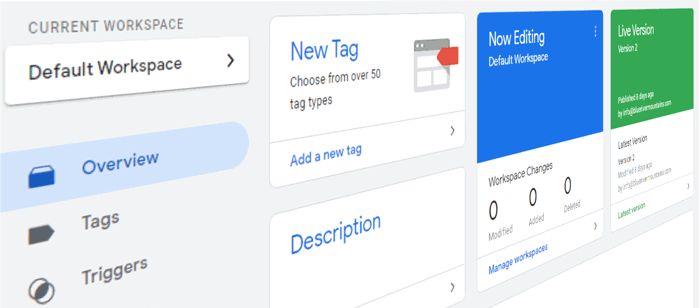How To Set Up Local Conversion Tracking

Last Updated on 25 September 2025 by Dorian Menard
Local conversion tracking helps you measure customer actions like phone calls, store visits, and form submissions specific to your business location. It’s essential for Australian businesses aiming to link online activity with offline results. Here’s a quick overview of what you’ll learn:
- Why it matters: Boost ROI by focusing on local leads, improve visibility in local search, and make better marketing decisions.
- What to track: Phone calls, direction requests, store visits, form submissions, and local bookings.
- How to set it up: Use tools like Google Ads, Google Business Profile, and Google Analytics 4 (GA4) to track and analyse local conversions.
- Key steps: Link your accounts, set up tracking codes, and assign conversion values for accurate ROI measurement.
Google Ads Conversion Setup

Tools and Access You’ll Need
To track local conversions in Google Ads, ensure you have the following:
- A Google Ads account with admin access
- A verified Google Business Profile
- Website admin access to add tracking codes
- (Optional) A Google Tag Manager account
Start by linking your Google Ads account to your verified Business Profile. This allows you to track local interactions effectively. Then, set up specific conversion actions tailored to your business needs.
How to Set Up Conversion Actions
Here’s how to configure conversion actions for your business:
- Phone Call Tracking
Go to ‘Tools & Settings’ > ‘Measurement’ > ‘Conversions’. Define a minimum call duration and assign a conversion value that aligns with your business goals. - Store Visit Tracking
Store visit tracking is available for eligible advertisers. Ensure your physical locations are connected to your verified Google Business Profile and meet Google’s eligibility requirements. - Local Form Submissions
Create a website conversion action to track local service inquiries. Give the action a clear name, assign a conversion value, and track unique form submissions. Here are 9 tips for optimising forms for local leads.
Once these actions are set up, the next step is to implement the necessary tags on your website.
Setting Up Google Tags

Follow these steps to install and configure your tags:
- Installing the Base Tag
Add the global site tag (gtag.js) to the header of your website. If you’re using Google Tag Manager, integrate it through your container.<!-- Global site tag (gtag.js) --> <script async src="https://www.googletagmanager.com/gtag/js?id=AW-CONVERSION_ID"></script> - Configuring Events
Set up tracking for key actions, such as:- Phone click events
- Requests for directions
- Local service enquiry form submissions
- Appointment bookings
- Testing Your Setup
Use Google Tag Assistant to confirm that your tags are installed correctly and that event tracking is functioning as intended.
Google Analytics 4 Conversion Setup

GA4 Setup and Code Installation
To set up Google Analytics 4 (GA4) for your website, follow these steps:
- Create Your GA4 Property
- Go to Admin > Create Property in your Google Analytics account.
- Choose "Web" as your platform.
- Enter your business details, including the appropriate Australian time zone.
- Install the Tracking Code
- Find your Measurement ID in the GA4 interface.
- Add the GA4 configuration tag to your website’s
<head>section. Use the following code snippet:
<!-- Google Analytics 4 tag --> <script async src="https://www.googletagmanager.com/gtag/js?id=G-XXXXXXXXXX"></script> <script> window.dataLayer = window.dataLayer || []; function gtag(){dataLayer.push(arguments);} gtag('js', new Date()); gtag('config', 'G-XXXXXXXXXX'); </script> Event Creation and Conversion Marking
Once your GA4 property is installed, set up events to track specific actions that are important for your business. For local businesses, consider defining custom events for actions like:
- Phone calls: Use parameters such as
call_durationandcall_type(e.g., mobile or landline). - Store visits: Capture data like
location_id. - Direction requests: Track how often users request directions to your store.
- Click-to-message actions: Monitor interactions like SMS or chat requests.
- Local inventory checks: Record when users check product availability in-store.
You can also track local enquiries by setting parameters for:
- Service type
- Location preferences
- Preferred contact methods
Setting Conversion Values
Assigning values to your defined events helps measure return on investment (ROI). Use the table below for guidance:
| Event Type | Suggested Value Range (AUD) | Value Calculation Method |
|---|---|---|
| Phone Calls | $25 – $150 | Average transaction value × conversion rate |
| Store Visits | $50 – $200 | Historical in-store purchase average |
| Form Submissions | $15 – $100 | Lead-to-sale ratio × average sale value |
These values should be based on historical data, seasonal trends, and averages specific to your services. Make sure to review and update them every quarter to keep your analysis accurate.
Local Action Tracking
Local Action Setup
Tracking customer interactions at your physical location starts with setting up location assets in Google Ads. This allows you to monitor key local actions that signal customer interest.
Here’s how to enable local action tracking:
- Location Extensions
Link your Google My Business (GMB) profile to Google Ads through location extensions. This helps track actions that indicate purchase intent, like visits or direction requests. - Call Tracking
Activate call extensions to generate unique forwarding numbers for better call tracking. Configure these settings:Feature Recommended Setting Why It Matters Call Reporting Enabled Tracks call duration and timing Call Recording Optional Useful for quality checks and training Minimum Duration 30 seconds Filters out non-meaningful calls - Direction Request Tracking
Use location extensions to monitor how often customers request directions to your store.
These tools help bridge the gap between online engagement and offline actions, giving you a clearer picture of customer behaviour.
Store Visit Tracking
Store visit tracking helps measure how your online advertising drives foot traffic to your physical locations. To use this feature, your business must meet specific criteria:
| Requirement | Details |
|---|---|
| Multiple Locations | Operate more than one physical store |
| High Ad Click Volume | Handle thousands of ad clicks per month |
| Verified GMB Listing | Keep your Google My Business profile accurate |
| Location Reporting | Enable location reporting in Google Ads |
Research shows that Google My Business plays a major role in generating leads.
To get the most out of store visit tracking, ensure your business hours, address, and location details are always up-to-date. A well-maintained GMB profile also boosts tracking accuracy.
For businesses targeting local customers, pairing store visit tracking with other conversion metrics provides a clearer understanding of your marketing impact.
These are some of the steps we cover when setting up campaigns for our clients, as part of our Perth SEO services.
sbb-itb-c74901f
Data Analysis and Improvement
Reading Conversion Reports

To optimise your campaigns, dive into conversion reports from Google Ads and GA4. Focus on these key metrics:
| Metric Type | What to Monitor | Why It Matters |
|---|---|---|
| Local Actions | Actions like direction requests, calls, and visits | Shows customer interest in your business |
| Conversion Value | Revenue per conversion, cost per lead | Helps calculate return on investment (ROI) |
| Time Analysis | Peak conversion hours, seasonal trends | Helps fine-tune ad scheduling |
| Geographic Data | Suburb performance, radius effectiveness | Improves targeting accuracy |
Pay attention to how online interactions lead to offline conversions. For example, do phone calls result in more valuable leads than form submissions? Identifying such patterns in customer behaviour can help you make better decisions.
Use these insights to fine-tune your campaigns for better performance.
Marketing Adjustments
Once you’ve analysed the data, tweak your marketing strategy accordingly:
- Conversion Rate Optimisation
Make sure your Google Business Profile is fully updated and set up for conversion tracking. This ensures you’re capturing all relevant data. - Budget and Geographic Optimisation
Action Implementation Expected Outcome Radius Adjustment Adjust targeting based on conversion density Better allocation of ad spend Suburb Targeting Focus on areas with strong performance Higher conversion rates Location Bid Adjustments Increase bids in profitable regions Improved ROI - Campaign Optimisation
Use your conversion insights to refine campaigns. For example:- Align ad schedules with peak conversion times.
- Improve landing pages based on user behaviour.
- Adjust keyword targeting to capture more local searches.
- Strengthen your online reputation to build trust and encourage conversions.
Conclusion
Setting up local conversion tracking is essential for businesses looking to link online interactions with offline results. By doing so, you gain a clear view of how digital engagement translates into real-world actions.
Using the tracking methods discussed earlier, you can make smarter marketing decisions. For example, an optimised Google Business Profile can generate a large share of local leads. Tools like Google Analytics and Google Ads help you measure your efforts and see what’s working.
"SEO generates qualified leads by boosting your organic visibility and conversion rates."
With conversion tracking in place, you can monitor key actions like store visits, phone calls, and direction requests. This data gives you the insights needed to fine-tune your campaigns and maximise your return on investment.
The key is in regularly reviewing the data. Analysing trends and customer behaviours allows you to adapt your strategy over time. This approach strengthens your local marketing efforts and ensures steady growth.
FAQs
How does local conversion tracking enhance my marketing strategy?
Local conversion tracking helps refine your marketing strategy by providing valuable insights into how potential customers interact with your business. By tracking specific actions, like calls, form submissions, or in-store visits, you can identify which campaigns are driving the most engagement and optimise your efforts accordingly.
This data empowers you to target the right audience, improve ROI, and focus on attracting high-quality leads. With a clearer understanding of your customers’ behaviour, you can make informed decisions to grow your business and better serve your local market.
What tools do I need to set up local conversion tracking for my business?
To effectively set up local conversion tracking, you’ll need Google Analytics and Google Ads. These tools work together to help you monitor and optimise how users interact with your business online and track key actions, such as calls, form submissions, or store visits.
Using these platforms, you can gain valuable insights into your audience, measure campaign performance, and refine your marketing strategies to drive better results.
How can I assign accurate conversion values to local actions to measure ROI effectively?
To assign accurate conversion values to local actions, start by identifying the specific actions that matter most to your business, such as phone calls, store visits, or form submissions. Assign a monetary value to each action based on its contribution to your revenue. For example, if a phone call typically leads to a $100 sale, you can assign that value to phone call conversions.
Use tools like Google Ads and Google Analytics to track these actions. In Google Ads, set up conversion tracking by selecting the action type, defining its value, and linking your Google Analytics account for more detailed insights. Regularly review and adjust these values to reflect changes in your business performance or customer behaviour, ensuring your ROI measurements remain accurate and actionable.